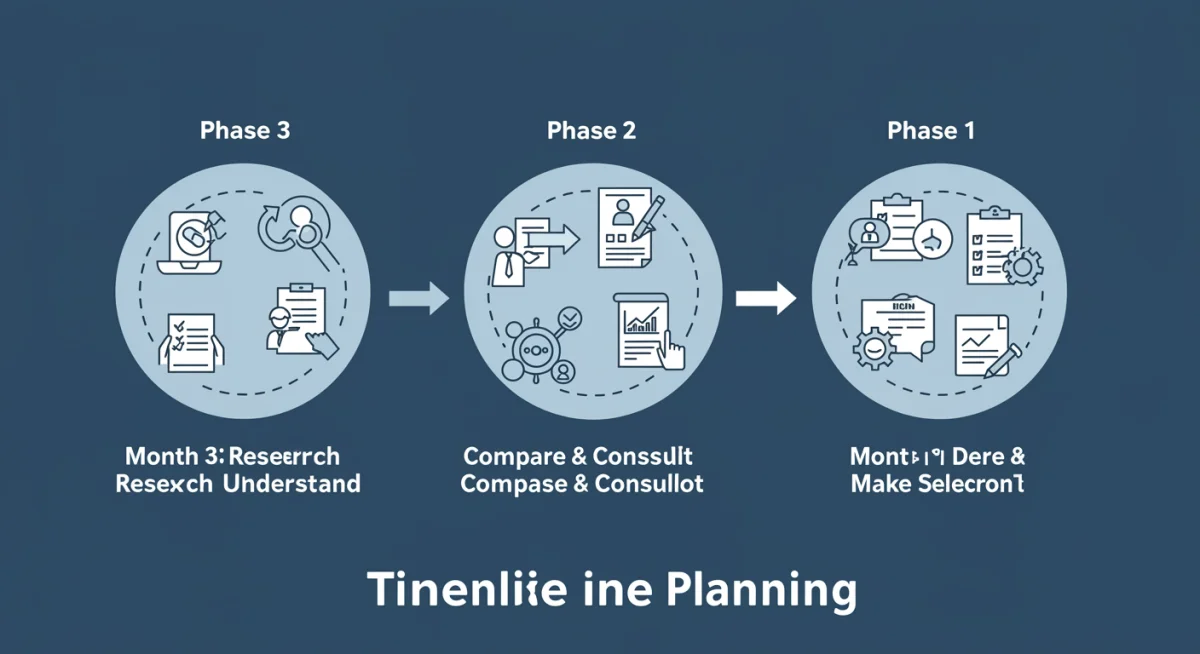2025 Employer-Sponsored Health Benefits: 3-Month Action Plan

Anúncios
A 3-month action plan is essential for effectively navigating 2025 employer-sponsored health benefits, ensuring employees understand changes, evaluate options, and maximize their coverage for comprehensive healthcare.
Preparing for healthcare coverage can often feel like a complex puzzle, especially with annual changes. This guide provides a strategic roadmap for navigating 2025 employer-sponsored health benefits, offering a clear 3-month action plan to help you confidently select the best options for your needs.
Anúncios
Understanding the Landscape of 2025 Health Benefits
As we approach the new year, employer-sponsored health benefits are continually evolving. Understanding these changes is the first crucial step in making informed decisions about your coverage for 2025. Employers are often adjusting plans to adapt to new regulations, rising healthcare costs, and employee needs, making it vital to stay informed.
The healthcare landscape in the United States is dynamic, influenced by legislative updates, technological advancements, and shifting economic pressures. These factors directly impact the types of plans offered, their costs, and the scope of services covered. Familiarizing yourself with these broader trends can provide context for the specific changes your employer might introduce.
Anúncios
Key Trends Shaping Employer Benefits
- Increased focus on preventive care: Many plans are emphasizing wellness programs and preventive services to promote long-term health and reduce overall costs.
- Telehealth expansion: Virtual care options continue to grow, offering convenient access to medical professionals for routine consultations and mental health support.
- Cost-sharing adjustments: Expect potential changes in deductibles, co-pays, and out-of-pocket maximums as employers balance coverage with affordability.
- Mental health parity: Continued efforts to ensure mental health services are covered at the same level as physical health services.
It’s important not to assume your current plan will remain identical. Even minor adjustments can have significant financial or healthcare access implications for you and your family. Proactive research and engagement are key to anticipating these shifts and preparing for the open enrollment period.
A thorough understanding of the general benefit landscape sets the foundation for a more detailed review of your specific employer’s offerings. By grasping the broader context, you can better interpret the nuances of your own health plan options.
Month 3: Initial Research and Information Gathering
The third month before open enrollment begins is your prime opportunity to lay the groundwork for a successful benefits selection. This period is dedicated to gathering preliminary information, understanding your current healthcare needs, and familiarizing yourself with general benefit terminology. Don’t wait until the last minute; early preparation reduces stress and allows for more thoughtful decisions.
Start by reviewing documents from your current plan. This includes your Summary of Benefits and Coverage (SBC), plan booklets, and any communications from your HR department regarding upcoming changes. These documents provide a baseline for comparison and highlight what you currently have versus what might be available.
Assess Your Current Healthcare Needs
Consider your family’s health status and anticipated medical needs for the upcoming year. This personal assessment is critical for choosing a plan that aligns with your specific situation.
- Doctor visits: How often do you and your family typically see doctors?
- Prescription medications: Do you or your family members take regular prescriptions? Check if they are on the plan’s formulary.
- Specialist care: Anticipate any specialist visits (e.g., dermatologists, physical therapists) or planned procedures.
- Wellness programs: Are there specific wellness initiatives or preventive screenings you plan to utilize?
This self-assessment helps you identify what features are most important in a health plan. For instance, if you anticipate many doctor visits, a plan with lower co-pays might be more beneficial, even if it has a higher premium. Conversely, if you’re generally healthy, a high-deductible health plan (HDHP) with a lower premium might be suitable, especially if paired with a Health Savings Account (HSA).
Begin to compile a list of questions for your HR department or benefits administrator. Early inquiry ensures you get comprehensive answers before the rush of open enrollment. This initial research phase is about building a solid foundation of knowledge, both about your needs and the general offerings.
Month 2: Deep Dive into Employer Offerings and Comparisons
With a foundational understanding of your needs and general benefit trends, the second month shifts focus to a detailed examination of your employer’s specific 2025 health benefit offerings. This is where you compare plans side-by-side, analyze costs, and identify potential advantages or disadvantages of each option. This stage requires careful attention to detail and a willingness to delve into the specifics of each plan document.
Your employer should provide updated benefits materials well before open enrollment. These typically include detailed plan summaries, cost breakdowns, and information on any new benefits or providers. Take the time to read through these documents thoroughly, highlighting key differences between plans.
Comparing Plan Structures and Costs
Focus on the financial aspects and coverage details of each available plan. This comparison will help you understand the true cost of care beyond just the premium.
- Premiums: The amount you pay regularly for coverage.
- Deductibles: The amount you must pay out-of-pocket before your insurance starts to pay.
- Co-pays and co-insurance: Your share of the cost for doctor visits, prescriptions, and other services after meeting your deductible.
- Out-of-pocket maximum: The most you will have to pay for covered services in a plan year.
Consider how different plan types, such as HMOs (Health Maintenance Organizations), PPOs (Preferred Provider Organizations), and HDHPs (High-Deductible Health Plans), align with your usage patterns. HMOs typically have lower premiums but restrict you to a network of providers, while PPOs offer more flexibility but often come with higher costs. HDHPs, when combined with an HSA, can offer tax advantages and lower premiums but require you to cover more upfront costs.

This month is also an excellent time to consult with your HR department or a benefits advisor. They can clarify complex terms, explain specific plan provisions, and help you understand how changes might affect your personal situation. Don’t hesitate to ask questions, no matter how basic they seem. The goal is to eliminate any confusion before making your final selection.
Month 1: Final Decision-Making and Enrollment
As open enrollment approaches and then begins, the final month is dedicated to making your ultimate decision and completing the enrollment process. All the research and comparisons from the previous months culminate here. It’s crucial to act decisively but also with careful consideration, ensuring all required steps are taken to secure your desired coverage for 2025.
Review all your gathered information one last time. Double-check your calculations regarding anticipated costs, compare network providers with your preferred doctors, and confirm that the plan aligns with your family’s health priorities. This final review helps solidify your choice and prevents last-minute regrets.
Key Steps for Enrollment Success
- Confirm deadlines: Be absolutely certain of your employer’s open enrollment start and end dates. Missing the deadline can result in default coverage or no coverage at all.
- Update beneficiaries: If applicable, ensure your beneficiary information for any life insurance or other benefits is current.
- Review dependents: Confirm all eligible dependents are correctly listed and enrolled under your chosen plan.
- Complete all forms: Carefully fill out all enrollment forms, whether online or paper-based, ensuring accuracy and completeness.
Many employers offer online enrollment portals, which can streamline the process. However, even with digital systems, it’s essential to review every selection before submitting. Print or save a copy of your enrollment confirmation for your records. This documentation can be invaluable if any discrepancies arise later.
If you have any last-minute questions or encounter technical difficulties during enrollment, contact your HR or benefits administrator immediately. Do not delay, as issues can take time to resolve, and deadlines are typically firm. Completing your enrollment accurately and on time ensures you will have the coverage you need when 2025 begins.
Maximizing Your Benefits Beyond Health Insurance
While health insurance is often the primary focus during open enrollment, remember that employer-sponsored benefits typically extend beyond medical coverage. Many companies offer a comprehensive suite of benefits designed to support employees’ overall well-being and financial security. Taking the time to explore and utilize these additional offerings can significantly enhance your total compensation package.
These supplementary benefits can provide crucial support in various aspects of your life, from financial planning to personal development. Overlooking them means missing out on valuable resources that can contribute to your long-being.
Exploring Additional Benefit Offerings
- Dental and vision plans: Often offered separately, these plans cover routine check-ups, cleanings, and corrective lenses, which are essential for overall health.
- Life and disability insurance: Provides financial protection for your loved ones in unforeseen circumstances.
- Retirement plans (401(k), 403(b)): Crucial for long-term financial planning, especially if your employer offers matching contributions.
- Flexible Spending Accounts (FSAs) and Health Savings Accounts (HSAs): Tax-advantaged accounts for healthcare expenses.
- Wellness programs: May include gym memberships, health coaching, or smoking cessation programs.
- Employee Assistance Programs (EAPs): Offers confidential counseling and support for personal and work-related issues.
- Tuition reimbursement: Supports continued education and professional development.
Understanding and strategically utilizing these additional benefits can lead to substantial savings and improved quality of life. For example, contributing to an FSA or HSA can reduce your taxable income while providing funds for out-of-pocket medical expenses. Participating in wellness programs can lead to better health outcomes and sometimes even lower insurance premiums.
Don’t just enroll; engage with these benefits. Attend informational sessions, read through the provided materials, and ask questions. Many benefits have specific enrollment periods or activation requirements, so knowing these details in advance is crucial. Maximizing your total benefits package contributes significantly to your overall financial and personal well-being.
Addressing Special Circumstances and Life Changes
Life is unpredictable, and significant events can impact your healthcare needs and benefit choices outside of the annual open enrollment period. Understanding how to address special circumstances and life changes is crucial to maintaining appropriate coverage and avoiding gaps in care. These qualifying life events (QLEs) trigger a special enrollment period, allowing you to make changes to your benefits without waiting for the next annual cycle.
It’s important to recognize that not all life events qualify. Typically, QLEs are events that directly affect your insurance eligibility or the number of people in your household. Being aware of these can save you from unexpected financial burdens or lack of coverage.
Common Qualifying Life Events
- Marriage or divorce: Changes in marital status often require updating your coverage for yourself or your spouse.
- Birth or adoption of a child: Adding new dependents to your family is a common reason to adjust health benefits.
- Loss of other health coverage: If you or a dependent lose coverage due to job loss, aging off a parent’s plan, or other reasons.
- Change in employment status: A new job, a significant change in work hours, or a spouse’s job change might impact eligibility.
- Relocation: Moving to a new area where your current plan’s network is unavailable.
When a QLE occurs, you typically have a limited window, often 30 or 60 days, to make changes to your benefits. Missing this window means you will likely have to wait until the next open enrollment period. Therefore, prompt action and communication with your HR department are essential.
Keep your HR department informed of any significant life changes. They can guide you through the process, explain your options, and ensure you submit all necessary documentation within the required timeframe. Proactive communication ensures that your health benefits remain aligned with your current life situation, providing continuous and appropriate coverage when you need it most.
Proactive Strategies for Year-Round Benefits Management
While the 3-month action plan focuses on navigating open enrollment, effective benefits management is a year-round endeavor. Taking proactive steps throughout the year ensures you are continuously maximizing your employer-sponsored health benefits and are well-prepared for future enrollment periods. It’s about staying engaged with your healthcare and financial well-being, not just during specific windows.
Many individuals tend to set and forget their benefits after open enrollment. However, a more strategic approach involves periodic check-ins and adjustments as needed. This continuous engagement helps you adapt to changes in your health, finances, or the plans themselves.
Ongoing Benefits Management Tips
- Review your Explanation of Benefits (EOB) statements: Regularly check EOBs for accuracy and to understand how your plan is covering services.
- Utilize wellness programs: Engage with any employer-sponsored wellness initiatives to improve health and potentially earn incentives.
- Monitor HSA/FSA balances: Keep track of your contributions and spending to ensure you’re maximizing tax advantages and using funds effectively.
- Stay informed about policy changes: Your HR department may send updates throughout the year; read them to stay abreast of any adjustments.
- Keep records: Maintain a file of all important benefits documents, including enrollment confirmations, plan summaries, and contact information.
By adopting a year-round approach, you can identify potential issues early, make timely adjustments, and ensure you are always getting the most out of your employer-sponsored benefits. This continuous engagement not only optimizes your healthcare coverage but also contributes to your overall financial health and peace of mind. Being proactive ensures that your benefits truly work for you, supporting your health journey every step of the way.
| Action Phase | Key Tasks |
|---|---|
| Month 3: Research | Assess current needs, review existing plan, understand general benefit trends. |
| Month 2: Compare | Deep dive into employer’s 2025 offerings, compare costs and coverage, consult HR. |
| Month 1: Decide & Enroll | Final review, confirm deadlines, complete enrollment forms, update beneficiaries. |
| Year-Round Management | Review EOBs, utilize wellness programs, monitor accounts, stay informed of changes. |
Frequently Asked Questions About 2025 Health Benefits
The first step is to assess your current healthcare needs and review your existing plan. This helps you understand what’s working and what might need to change, forming a baseline for comparing new options.
A 3-month action plan provides ample time to research, compare, and make informed decisions. It minimizes last-minute stress, allows for thorough understanding of complex plan details, and helps maximize your coverage effectively.
When comparing plans, focus on premiums, deductibles, co-pays, co-insurance, and out-of-pocket maximums. Also, consider the provider network, prescription drug coverage, and whether the plan type (HMO, PPO, HDHP) suits your needs.
Yes, you can change benefits outside of open enrollment if you experience a qualifying life event (QLE) such as marriage, divorce, birth of a child, or loss of other coverage. You typically have a limited window (e.g., 30-60 days) to make these changes.
Maximize benefits year-round by regularly reviewing EOBs, utilizing wellness programs, monitoring HSA/FSA balances, and staying informed about any policy updates from your HR department. This proactive approach ensures continuous optimization.
Conclusion
Successfully navigating 2025 employer-sponsored health benefits requires a proactive and structured approach. By following a strategic 3-month action plan, individuals can move beyond simply choosing a plan to truly optimizing their healthcare coverage and overall well-being. This involves thorough research, careful comparison of options, timely enrollment, and ongoing engagement with all available benefits. Ultimately, an informed approach to your benefits ensures that you and your family are well-protected and financially secure for the year ahead.





